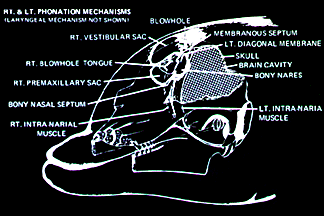
|
During our investigation with the phonation of the dolphin we were puzzled by the doubling of the phonation apparatus. Inside the opened blowhole, the passage is double, even as it is in our noses. On each side of the dolphin's nose which is here turned up on the forehead, is a complete set of sacs, muscles, tubes, and a separate vocalization membrane. There is a right phonation apparatus and a left phonation apparatus, each one in its half of the nose. Some of the features of the right apparatus are usually larger than those of the left one. We had come this far in the state of our knowledge in the previous book, Man and Dolphin. This set of puzzling anatomical facts continued to bother me. When the dolphin gave us controlled, humanoid sounds in air we saw that the two sides were operating quite independently of one another. We took high-speed motion pictures of the activities of the blowhole and found that this was the truth. When these pictures were slowed down we saw that the two sides of the blowhole plug or the two "tongues" (as we now call them) were being used separately in the production of the airborne sounds. With more complete and more sophisticated methods, we have now demonstrated that the dolphin can not only produce sounds on each side, separately and independently, but that he can intermix the two sets of sounds, sequentially and simultaneously. Because of this, dolphins can speak "in stereo"; a conversation between two dolphins sounds like four individuals.
|




